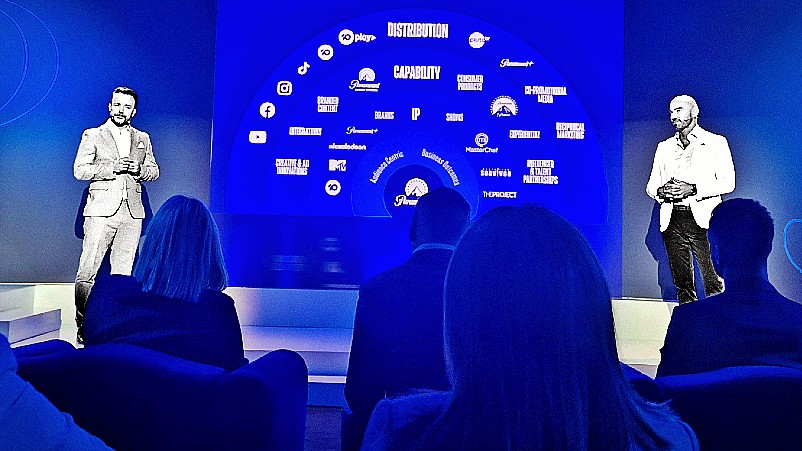Paramount goes all-in on converged trading across BVOD, SVOD, AVOD, FAST – linear set for mid 2025

Bringing it all together: Paramount's Rod Prosser (right) and Daniel Monaghan.
Paramount has landed the first of the TV network's 2025 upfronts pitches, slinging a first in market unified total TV trading platform that promises to target and deliver audiences across BVOD, SVOD, AVOD, and FAST assets in a single play by early 2025 – with linear following mid year. Paramount Connect plays into TV's convergence and coming tipping point, with buyers long itching at the friction of siloed transactions, per sales chief Rod Prosser. The new set-up will provide buyers with a "compelling blended CPM" that Prosser reckons will offer a more tempting entry point into premium Paramount+ inventory. That ad tier inventory is currently limited but, he claimed, is climbing in line with its broader streaming subscriptions, estimated by Telsyte to be up 18 per cent in the 12 months to June – the fastest growth in market. Elsewhere, the network has caught up to the competition on shoppable CTV, and Big Brother returns.
What you need to know:
- A new converged trading platform was the biggest news to come from Paramount's 2025 upfront, following through on the networks vision of a one Paramount offering that rolls streaming service Paramount+ in with its other TV assets.
- Paramount Connect will launches with audiences across BVOD, SVOD, AVOD and FAST channels in early 2025 – January or February per sales chief Rod Prosser. Linear is "on the roadmap" but not until the second half of the year, with nuances between linear and CTV tech and measurement systems pushing out the deadline on the total TV view.
- Prosser said the move answers buyer calls to remove the friction from what has traditionally been a siloed transaction process, providing a "compelling blended CPM" to boot.
- For international sales boss Lee Sears, the volumes that will now move through the Connect platform globally will give Paramount greater leverage with ad tech partners, which will trickle down to advertisers.
- Prosser said Paramount won't be providing audience numbers on the Paramount+ ad tier, but claimed they've exceeded internal benchmarks – and that ad tier growth is tracking inline with the 18 per cent estimated total annual subscriber growth published by Telsyte earlier this month.
- Other key upfronts announcements include an expanded shoppable CTV offering, and a 2025 programming slate that includes all the usual favourites, new commissions, and the return of a new and improved Big Brother to Network 10 after 16 years.
One vision
Paramount Australia has delivered on its promise to streamline total TV buying through a “one Paramount” approach – or at least it will have, by next year.
The first of the TV networks to host its upfronts for the year ahead, Paramount is charging towards converged trading with a touted ‘first in market’ advertising technology it’s dubbing Paramount Connect.
Per the firm, the unified trading platform, already trialled and tested in the US market, will give advertisers and agencies a single customer view across linear, BVOD, SVOD, AVOD and FAST assets, with which they can target and deliver to the 16.1 million Australians Paramount claims it now reaches across the piste.
“How it differs from what we have today is, rather than having a siloed approach, in terms of how we sell and transact our inventory across the various platforms, [Paramount Connect] essentially allows us to put all of our inventory into a unified ad server, which allows advertisers to transact across the various platforms,” said Paramount sales chief Rod Prosser.
As one senior holdco agency buyer told Mi3, the move to converged selling is symptomatic of where the broader market as at, with the long awaited VOZ trading currency just around the corner. That’s to say, Connect was an expected but necessary evolution for Paramount – though to be first out the door is a cherry on top.
On track to debut in the “January-February period”, per Prosser, the new tech will initially only include Paramount+ and 10 Play, plus circa 50 FAST channels on Pluto TV. In keeping with the broader convergence theme, 10 Play itself is set to be rebadged as ‘10’ from next year, repositioning Paramount’s BVOD and linear offerings as one in the eyes of the consumer (or preparing for the future tipping point, whenever that comes.)
“Phase one is to really bring that into a unified ecosystem, to allow advertisers to really access an addressable audience with a single customer view, which means that we can overlay our data out and our various segments," said Prosser.
Linear trading will come later in the piece and “will take a little more time”, he added, but it’s slated for the second half.
For now, the platform will sit internally within Paramount’s stack – with migration currently ongoing. But in the long term, Prosser said the network is considering how it might evolve into a self-service platform in future.
Blended CPM
The new tech should mean Paramount can ensure campaign delivery across its assets, and more dynamically wring the most out of them, while removing transaction friction for agencies. "They've been crying out for that," said Prosser.
Paramount international sales boss Lee Sears added that the volumes that sit in the global Connect will also translate to greater leverage with tech partners: “We’re one of their biggest customers… if we need to get things done quickly for the benefits of our clients, we can move quickly.”
The implication was that local rivals may not have such heft.
The delivery of a “compelling blended CPM” is a big part of it too, particularly for those looking to activate on Paramount+, which attracts a premium price tag when bought alone – in part because the ad tier audience started at a nil base when it launched in June, eschewing the fast-tracked strategies of Amazon Prime Video and Foxtel’s Binge.
“We have a finite amount of inventory on SVOD – obviously, less than we would on our linear and or AVOD or BVOD platforms. But it's also super premium, and the audience is hard to get," said Prosser.
“But once you incorporate the buy to sit across all platforms, we can obviously reduce the CPM. Yes, it will be blended, so some shows or some platforms will be higher [priced] than others. But ultimately, net-net, it will be a compelling CPM in market.”
It means the new server will still allow buyers to pick and choose the platforms they want to target – and to get much more granular as well.
“You can optimise a campaign as you would normally, [but] the more restrictive it becomes, the harder it is to achieve what will be a compelling blended CPM," per Prosser. “But that's okay, because advertisers understand if they only want a certain style of content or genre, then that'll impact overall CPM.”
Ad tier building
It’s been a slow and steady start for the Paramount+ ad tier, which has been building out an audience by mode of attrition since its June launch – whereas the likes of Amazon and Foxtel rolled all basic subscribers onto ads automatically in a bid for instant scale.
That meant Paramount had to push out most of the SVOD inventory via bundled packages with 10 Play and Pluto TV “to ensure we could deliver the impressions”, said Prosser. “I guess we just didn't want to disappoint the first outing.” (A lesson Netflix had to learn after its ads launch initially disappointed buyers locally.)
He said the cautious approach is starting to pay off – Paramount+ was estimated to be the fastest growing streaming service in the Australian market in the latest figures from Telsyte. The research firm put the total Paramount+ audience at 1.8 million as of June 2024, up 18 per cent on the same time last year. Prosser would not disclose ad tier subscriber numbers – nor will the firm share them with agencies, as Paramount+ is “impression based” – but told Mi3 that it’s following the same growth trajectory.
“We excelled in our internal benchmarking, which is really great. Hence my point, now we’re really comfortable around delivery on Paramount+, so we don’t reveal those numbers – and we don’t sell it that way anyway.”
But speaking to audiences at Monday’s upfront, Prosser gave an indication of scale that may have surprised some, claiming Paramount+ "reaches an incremental 1 million unduplicated viewers that were not previously in reach".
Those claims merit further investigation (update: that claim is based on potential to reach those streaming viewers via integration). Omnicom chief investment officer, Kristiaan Kroon, last week described the variations in numbers bandied around by some platforms and buying groups as “quite wild” across the market.
Amazon is thought to have somewhere between 1.4 and 2.5 million weekly active audiences on its video ad tier – depending on who you ask.
Netflix, which leads the market on total streaming subscribers, is touting 800,000 monthly active users on its ad tier and is now looking to compete against local players with a newly in-housed sales team, though local headcount is lean.
Either way, slinging a converged TV product could prove a key competitive edge for Paramount against the deep pockets of the global streamers, and a differentiate its BVOD and linear assets from other local networks – Nine’s Stan for now remains without and ad tier, and Seven is yet to make an SVOD play.
Big shopper
After announcing Shoppable TV at last year’s upfront, Paramount has completed a successful proof-of-concept pilot with Australian Survivor that will be the blueprint for a global rollout of the company’s CTV advertising offering.
Locally, new ‘Pause to Shop’ opportunities will be available across tentpole programs including Australian Survivor and MasterChef Australia. The format will allow advertisers to leverage brand exposure or, taking a leaf out of Amazon's book, even the appearance of similar products or services in specific on-screen moments to drive product discovery.
At the more premium level, ‘Own the Moment’ will pull in-program moments into the first ad-break with shoppable brand slots that dynamically match on-screen scenes to the advertiser’s products or services.
Some might argue that is perhaps making the main screen in the home too disruptive, but Prosser suggested otherwise.
"It's really not that invasive – it's really second screen type of stuff. So you stay engaged with what's happening on the main screen, but you can shop while you're watching or pausing," he said. "We're not going to plaster it everywhere. It's still a premium product, obviously, so we'll be cautious about how much we release. But the discussions around shoppable have been really good, and there's a lot of them."
The formats will be backed by expanded relationships with KERV and Innovid, the latter of which will allow advertises without a brand TVC to utilise existing social media and vertical video assets for CTV.
There's also a suite of new data partnerships with retail media platform Circana, the Australian Bureau of Statistics and an unnamed global payment provider, adding to existing relationships with smrtr, Coles 360 and Samba TV.
Those partnerships will boost Paramount’s first-party data, which now come in 80 curated segments called ‘Paramount Personas’ – not unlike Nine’s Tribes.
Big Brother
Beyond ad tech, the big announcement of the day was the return of Big Brother to Network 10. The live reality program, pitched by SVP of content and programming Daniel Monaghan as more “authentic” and nationally representative than iterations of the show aired by other networks, will make its return to the network in Q4 of 2025.
“We want a live show. We want to have live nominations, live evictions, and fast turnaround in the same way that it used to be when it was on Ten [previously].”
Big Brother joins a slate of returning reality programs, plus a revitalised ‘Talking About Your Gen’ and a new weekly show from comedian Sam Pang. Other programs on the sizzle reel included an Australian version of UK comedy Ghosts, a new travel program from the Inspired Unemployed, both of which will air across 10 and Paramount+, while original drama series Gracie Darling will premiere on Paramount+.


